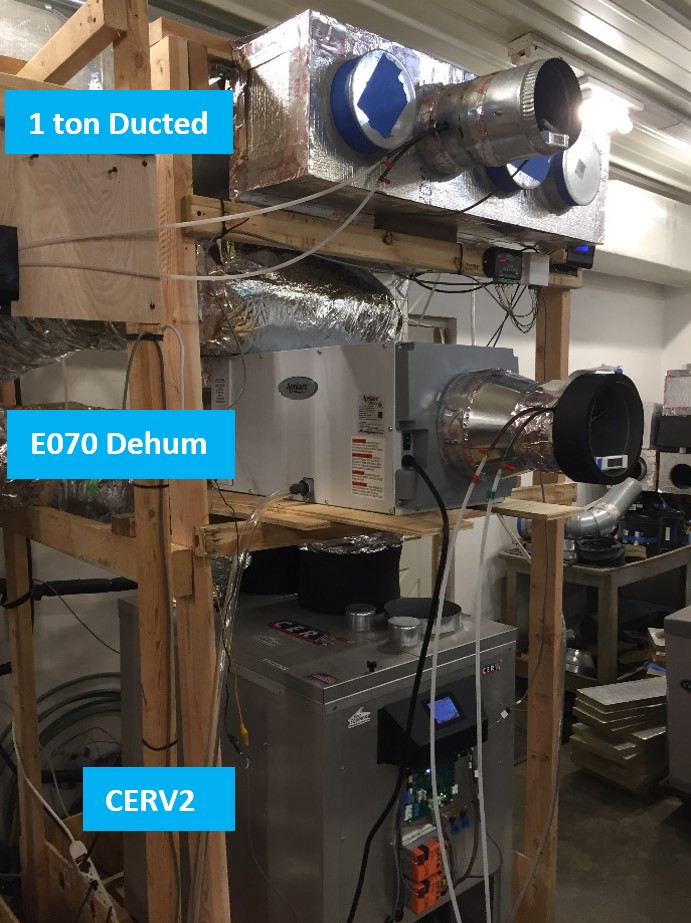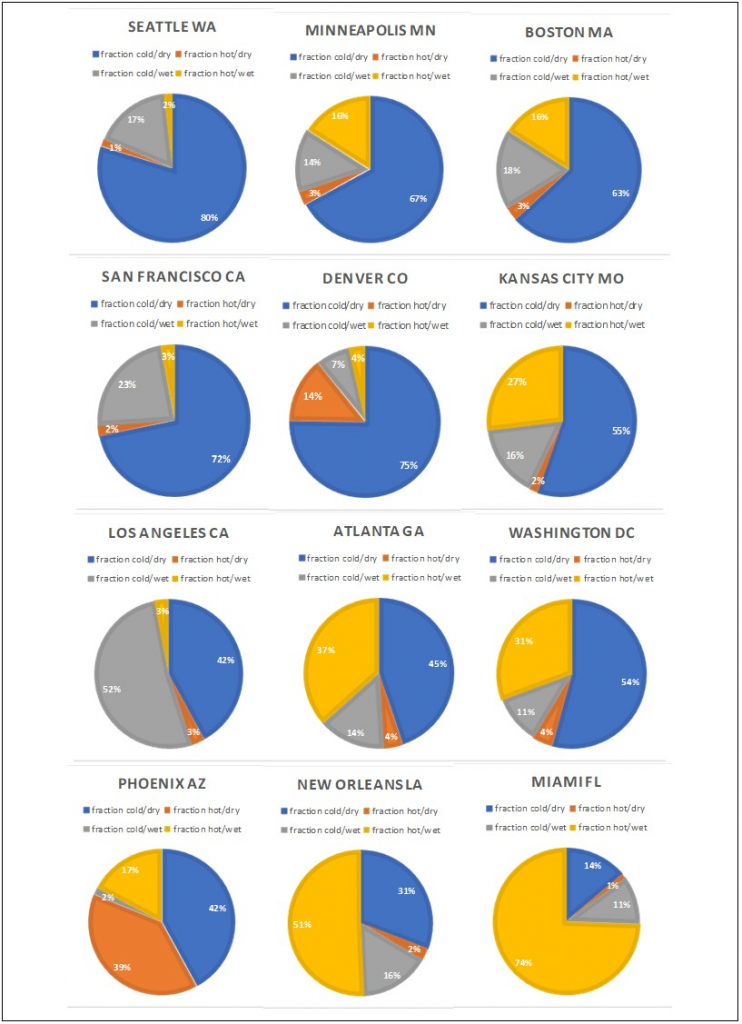The CERV2 does more than control air quality, temperature and humidity in a seamless manner. CERV2 integrated moisture management supercharges dehumidification by increasing both dehumidification capacity and dehumidification efficiency!
Moisture Management
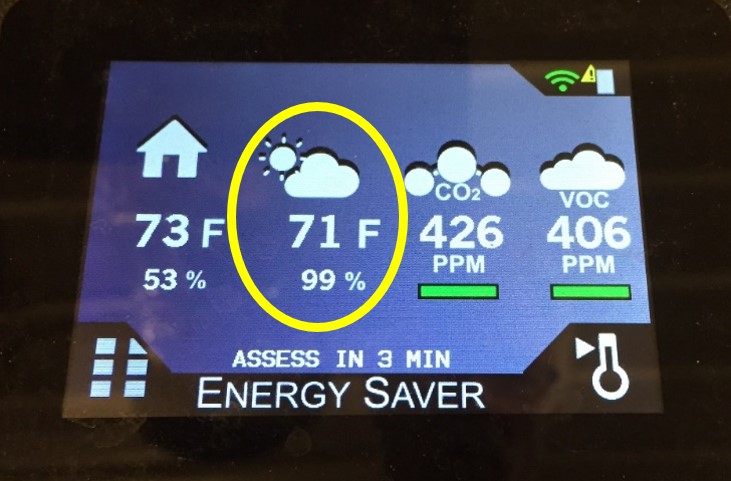
30% more energy must be removed from air at 71F and 99% relative humidity air than must be removed from air at 100F and 20% relative humidity to maintain 71F and 50% relative humidity! Uncontrolled humidity impacts our health and productivity. High humidity increases dust mite activity that triggers asthma attacks, high humidity encourages mold and mildew growth that degrades our health and buildings, and uncontrolled variations of humidity warps and shrinks materials such as wood in flooring, furniture and musical instruments. We lose our ability to cool by perspiration evaporation as indoor humidity increases above 60% relative humidity, but our bodies don’t realize this and continue producing excessive, ineffective sweat.
The need for moisture management increases as our homes are sealed and insulated. Unfortunately, today’s high SEER air conditioners are moving in the opposite direction with reduced moisture management capability. For example, Mitsubishi’s 2010 1 ton, ductless Hyper Heat (MSZ-FE12NA indoor and MUZ-FE12NAH outdoor units) reported a SEER of 23.0 with a moisture removal capacity of 2.9 pints per hour. A few years later, Mitsubishi released a new Hyper Heat unit (MSZ-FH12NA indoor and MUZ-FH12NAH outdoor) with 13% SEER increase to 26.1. Moisture removal capacity dropped 35% to 1.9 pints per hour.
One of the unfortunate consequences of improving SEER values is reduction of dehumidification capability because the factors that enhance SEER numbers (increased fin surface, increased air flow, reduced compressor speed) decrease latent conditioning capacity. Mitsubishi’s ¾ ton units (“09” units) reported 17% SEER gain from 26.0 to 30.5 while suffering a whopping 62% moisture removal loss from 2.1 pints per day to only 0.6 pints per day.
For more information on managing moisture in buildings, read our 4-part “Handling Humidity” report series (Moisture Generation in Homes – Part 1, Climate Moisture Variations – Part 2, Methods for Managing Moisture – Part 3, Putting It All Together House Moisture Modeling – Part 4).
Supercharging Comfort Control with CERV2 Integrated Ducted Minisplit and Ducted Dehumidifier
Integrating a ducted minisplit heat pump and ducted dehumidifier with a CERV2 smart ventilation unit supercharges a home’s dehumidification capacity and dehumidification efficiency. Synergistic performance of CERV2, ducted minisplit and ducted dehumidifier results in exceptional IAQ, temperature and humidity control. A bonus is the CERV2’s clean, filtered (MERV 13) air supplied to both minisplit and dehumidifier units.
No additional mechanical room space is needed for an integrated minisplit and dehumidifier system because the units nest together above the CERV2. The CERV2’s plug-and-play operation simplifies integrated comfort and humidity control!
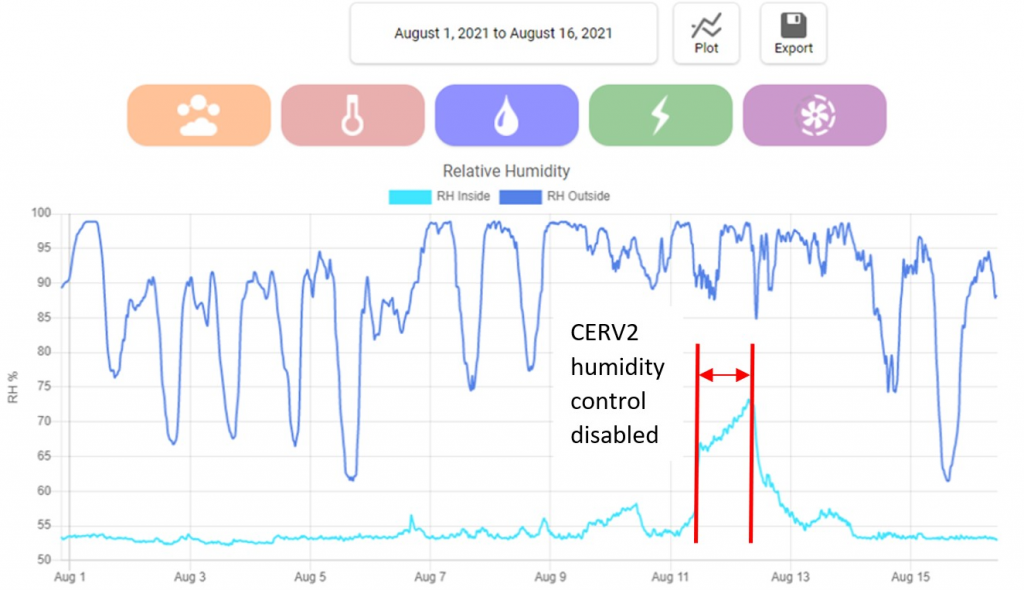
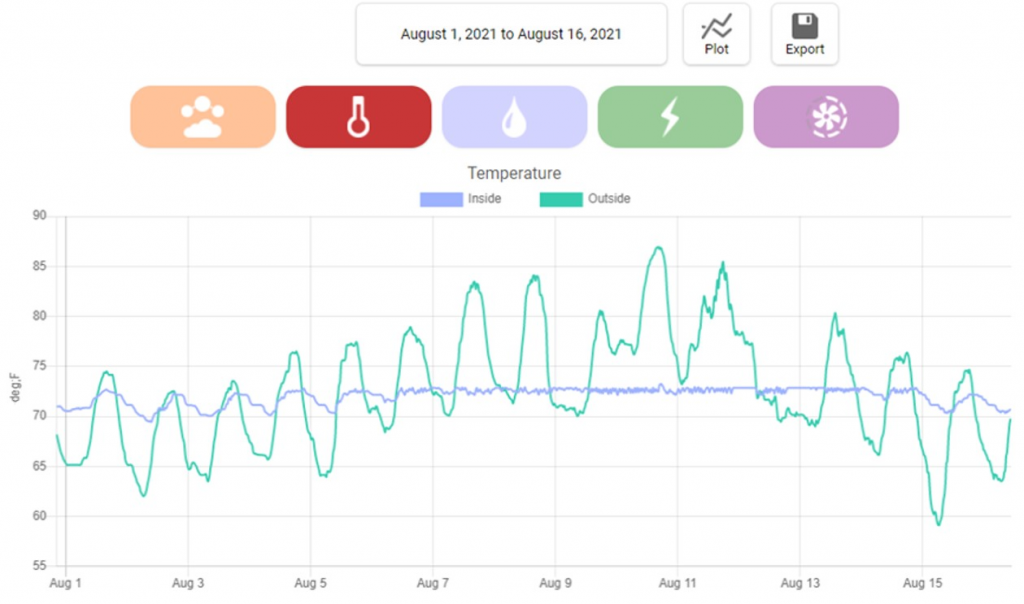
August 2021 plots of indoor and outdoor humidity and temperature for our Build Equinox building demonstrate the effectiveness of CERV2 controlled comfort. The first part of August was cool and humid, followed by hot and humid weather, and a second cooler but still humid weather period.
The Aprilaire unit was disconnected and capped from August 11 to 12 to demonstrate operation without humidity control. Our Build Equinox building climbed to 65% relative humidity within a couple of hours. Building humidity continued to increase to 75% relative humidity. We re-connected the dehumidifier on August 12, with the CERV2-Mitsu-Aprilaire system restoring the building back to 55% relative humidity within a day.
Temperature remained in control throughout August, with the CERV2 modulating and alternating between “free conditioning” during nice weather (equivalent to automatically opening windows, except fresh air from the CERV2, unlike an open window, is filtered). As warmer weather returned in mid-August, the CERV2 increased its cooling capacity, and then added the Mitsubishi’s cooling capacity as needed. Note that the CERV2 “inverter drive” (speed control) compressor modulates its capacity to achieve an integrated system performance higher than the individual ducted minisplit operation.
More Than Meets the Eye
The CERV2 modulates its capacity and power as it controls the minisplit heat pump and dehumidifier units. Efficiencies of both minisplit and dehumidifier are increased by the CERV2’s integrated “psychrometric” control operation. CERV2 coordinated operation of IAQ and comfort (temperature and humidity) is more than just simply switching units on and off.
Integrated CERV2-Mitsubishi-Aprilaire dehumidification capacity is increased by more than 300% and dehumidification efficiency is doubled in comparison to conventional, non-integrated operation! The secret to enhanced moisture performance is the CERV2’s ability to condition fresh, filtered outdoor air before it mixes with indoor air. Conventional comfort conditioning systems dehumidify indoor air after outdoor ventilation air has mixed with indoor air.
Throughout the 2021 summer, we have collected performance data from combined CERV2-Mitsubishi-Aprilaire integrated operation. The data is real data. That is, our 4500sqft Build Equinox facility is actively controlled under real world conditions, and we are experiencing the resulting comfort directly.
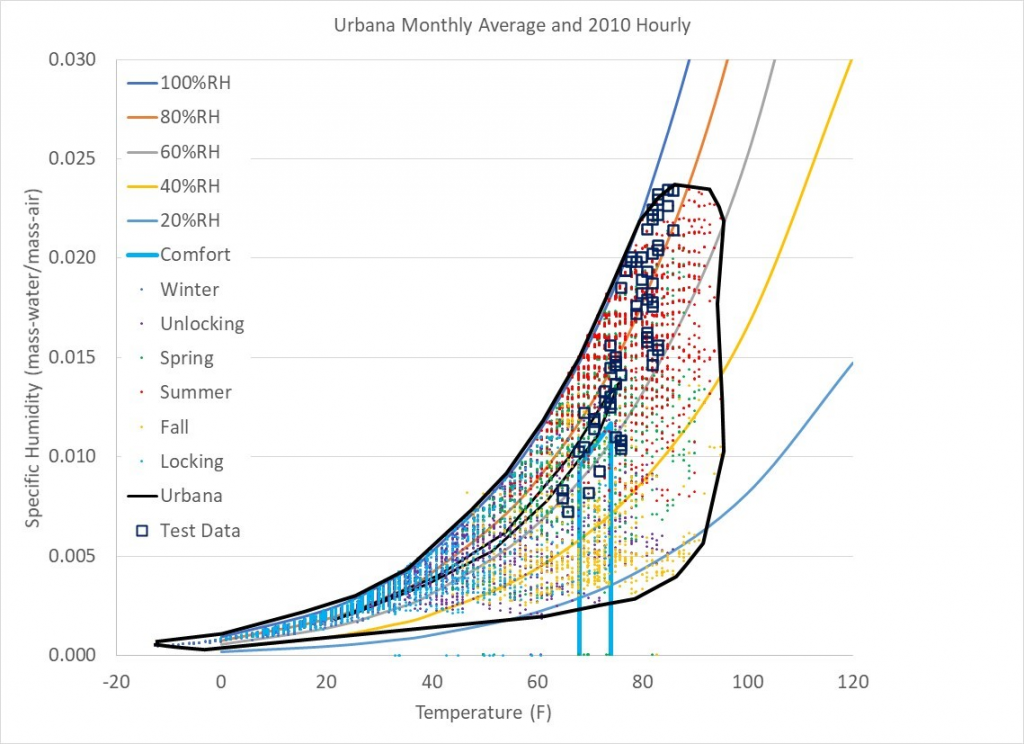
The figure above shows our test data (open squares) on a psychrometric (temperature versus humidity) plot. Also shown on the figure is hourly data from 2010 for Urbana Illinois, monthly average temperature and humidity conditions for Urbana, and a line that outlines Urbana hourly data. Each test data point represents approximately 1 to 2 hours of operation (some data points are shorter and some are longer time periods) in which we monitored the power, temperature, humidity, and condensate of each unit (CERV2, Mitsubishi ducted minisplit, and Aprilaire E070 dehumidifier). Most data points are for outdoor air (fresh air vent mode) passing through the CERV2, and then split between the minisplit and dehumidifier units.
We operated in multiple manners with varying levels of air flow, and CERV2 operation modes. For example, we alternately operated the CERV2 in cooling mode and “off” mode in order to determine the CERV2’s air pre-conditioning benefit to minisplit heat pump and dehumidifier operation. Typical airflows for combined operation were 400 to 450cfm with the ducted minisplit receiving up to 300cfm and the dehumidifier receiving 150cfm. Fans for all three units interacted in a beneficial manner, with no fan resonance or air flow interference over all combinations of unit operation and fan speed modulations (the Aprilaire is a fixed speed fan while the CERV2 and Mitsubishi units can modulate air flow).
A plot of combined system dehumidification capacity data from our tests show moisture removal capacity increases as humidity ratio increases. Humidity ratio is the ratio of water vapor mass to air mass, and a humidity ratio of 0.01 indicates that approximately 1% of a room’s air is water vapor (by mass). Humidity ratios between 0.008 and 0.01 are preferred for indoor comfort, which is 50 to 60% relative humidity at typical indoor temperatures (71-72F or 22C).
At room condition humidity ratios (0.008 to 0.01), combined system dehumidification capacity is 1.5liters per hour (76 pints per day). Data points (yellow) denoted as “room condition” were collected with the CERV2 in recirculation mode, in which room air passed through the CERV2, minisplit heat pump and dehumidifier units. All other data points shown were from “fresh air venting” operation in which outdoor air passed through the CERV2 (with and without CERV2 pre-conditioning outdoor air) before passing through the minisplit heat pump and dehumidifier.

Dehumidification performance increased as humidity ratio increased. At the highest humidity ratio (0.023), total system dehumidification increased to 6 liters per hour (304 pints per day)! Rainy day performance is marked on the plot with very high dehumidification capacity occurring at relatively low humidity levels. The rain lasted for 2 to 4 hours. During the rain, humidity levels were below water vapor saturation (100% relative humidity), however, dehumidification rates were very high. We speculate that aerosolized rain droplets were entrained in fresh air to the CERV2. Although such droplets would be caught in the CERV2’s MERV 13 filter, water passes through the filter unlike dirt that is captured in the filter material. As the rain ended, humidity levels increased, with the system’s performance moved toward other data points collected during non-precipitation periods.

Dehumidification efficiency also increases as humidity increases. At room condition humidity levels, dehumidification efficiency was found to be 1liter per kWh. The Energy Factor, EF, for the combined system more than doubled to 2.5 liters per kWh as humidity increased. Rainy day data points show very high levels of performance, possibly due to aerosolized droplets impinging on the wet cooling coils, adding to condensate recovered without needing to be condensed. Note that these droplets would have passed into the indoor environment in conventional systems where they would vaporize and need to be removed by dehumidification.
The combined dehumidification efficiency is low compared to “Energy Star” dehumidifier efficiency listings because Energy Star listings neglect the energy required to remove heat from dehumidifiers. Aprilaire dehumidifiers are top performing units with Energy Star performance levels of 2.35 liters per kWh. Part 3- Methods for Managing Moisture from our Handling Humidity report series explains why actual dehumidifier performance is different than Energy Star test ratings (see Figure 19, page 24). A dehumidifier with an EF of 2.35liters per kWh based on 80F and 60% relative humidity test conditions has an actual performance of 1liter per kWh at a temperature of 70F when the impact of its internal heat load on building conditioning is included in the efficiency rating.
In summary, our performance tests indicate the following:
1) Removing moisture from humid air before it mixes with indoor air can more than triple dehumidification capacity
2) Removing moisture from humid air before it mixes with indoor air can more than double dehumidification efficiency
What about alternative methods for managing humidity? Don’t ERVs automatically manage moisture in humid regions? The short answer is, no, ERVs do not effectively manage humidity even though they are commonly thought to do so. When an ERV is ventilating a 100% humidity bathroom, moisture is added to incoming fresh air, even in humid Miami and Houston. For the longer answer (but with real field data) demonstrating poor humidity control with ERVs, read Build Science Corporation’s report on moisture management in homes.
CERV2 Integrated Control of Moisture…Will it play in Peoria, or Miami?
A CERV2 integrated minisplit heat pump and dehumidifier works great in Urbana Illinois, and because we have the same weather, it will do well in Peoria, but what about elsewhere? A psychrometric plot for Miami showing hourly weather data from 2010 and Urbana’s weather “envelope” and test data conditions verify that we can handle as high of humidity conditions that Miami can dish out. Place our 1988 vintage, 4500sqft Morton Building in Miami, or Houston, or anywhere in North America, and our CERV2 with 1 ton ducted minisplit and ducted dehumidifier system will keep both temperature and humidity in control more efficiently than any other system!
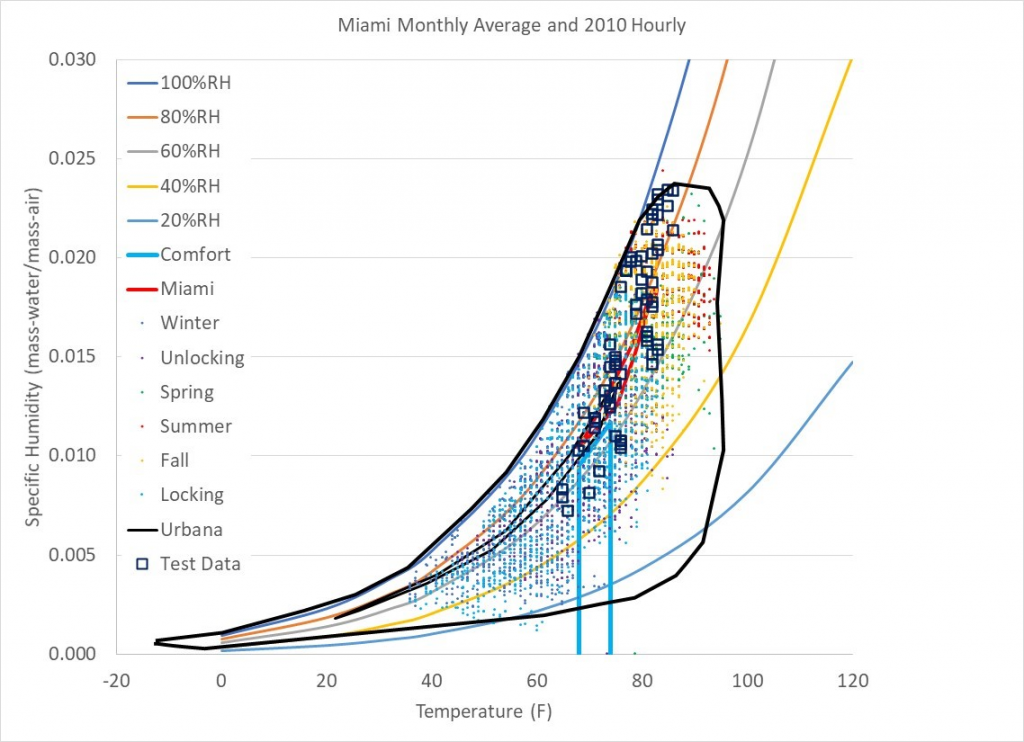
Read Part 4- Putting It Altogether; House Moisture Modeling of our Handling Humidity series to see why smart ventilation is much more efficient than constant flow ventilation systems, and why smart ventilation is essential for keeping air healthy. Conventional constant flow ventilation systems are only good at keeping air healthy when you are not at home.
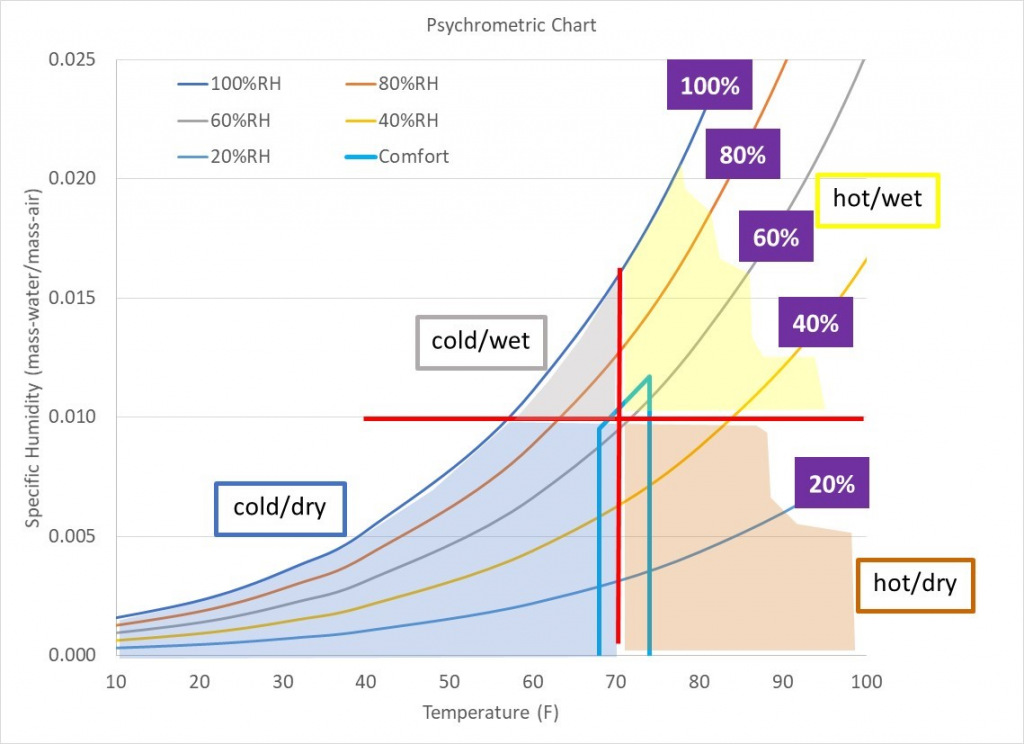
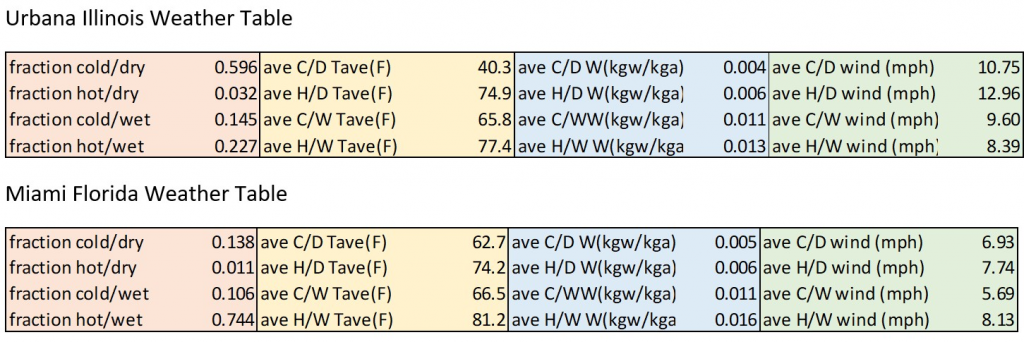
Pie charts showing comfort quadrant time fractions for several US locations are also attached. The pie charts (from Part 2 of Handling Humidity reports) are organized in a roughly geographic placement, showing how comfort conditioning varies as one moves north to south and east to west. The west coast primarily requires dehumidification due to cool-humid conditions while the east and Gulf coast are dominated by warm-humid conditions. Throughout much of the Midwest, significant periods of warm-humid and cool-humid conditions require moisture management. The intermountain and Great Basin regions, as observed for Denver, have low dehumidification requirements.
Fresh air brought into a house is more efficiently dehumidified when it is directly conditioned by the CERV2 integrated system as described in the previous section. Over the course of a year, one person should have a minimum of 20cfm (cubic feet per minute) of fresh airflow per person. This is somewhat greater than standard building ventilation conditions (ASHRAE 62.2-2019), but is half of the 40cfm per person that Build Equinox recommends for a truly healthy indoor environment. We will assume 20cfm per person for our examples, but stress again, the building industry needs to increase their fresh air standards!
A fresh air ventilation rate of 20cfm per person is equivalent to 1000kg of air (a metric ton) per person blown into (and out of) a house per day! We can determine how much water must be condensed from this air for Urbana and Miami (and several more locations with tabular data in Part 2 of Handling Humidity). The following relation calculates the total amount of water that must be removed from ventilation air during humid conditions:
Mwater = Mair x F x 365days x (Wo – Wi)
Where
Mwater = water removed from ventilation air per year (kg or liters)
Mair = ventilation air mass blown through a house per day
F = fraction of year with humid conditions (for cool-humid and warm-humid periods)
Wi = indoor humidity ratio (=0.0089 for 72F and 55% relative humidity indoor air)
Wo = average outdoor air humidity ratio for cool-humid or warm-humid quadrants
Urbana Example:
Urbana is in warm-humid conditions for 22.7% of the year with an average outdoor humidity ratio (Wo) of 0.016 (remember, humidity ratio is simply the ratio of water vapor mass per dry air mass). The amount of water per person per year that must be removed during Urbana’s warm-humid season is:
Mwater = 1000kg-air/day-person x 0.227 x 365days/year x (0.016 – 0.0089)kg-water/kg-air
Mwater = 574kg-water per person per year removed from ventilation air during warm-humid conditions
A similar calculation shows that 111kg-water per person must be removed from ventilation air during Urbana’s cool-humid season.
Once we know the amount of water removed and the average weather conditions, we can determine the electrical energy needed to remove the moisture. As described previously, conventional fresh air ventilation systems mix outdoor air with indoor air, which reduces dehumidification capacity and efficiency. From our dehumidification system efficiency plot (Liters per kWh versus humidity ratio), we see that the components we’ve integrated into the CERV2 operate at 1liter per kWh at room condition humidity ratios (~0.008 to 0.01). During Urbana’s warm-humid period, dehumidifying outdoor air at an average outdoor humidity ratio of 0.016 increases the dehumidification efficiency factor to 2liters/kWh (and dehumidification capacity to 4 liters per hour). Dehumidification energy is calculated as:
Outdoor air mixed with indoor air:
Edehum = Mwater / EF = 574kg-water / 1liter per kWh = 574kWh per person per year
Outdoor air conditioned directly by CERV2 integrated system before mixing with indoor air
Edehum = Mwater / EF = 574kg-water / 2liters per kWh = 287kWh per person per year
Assuming an electricity cost of 12 cents per kWh, conventional dehumidification cost $69 per person per year for ventilation air moisture removal versus $35 per person per year for ventilation moisture removal for the CERV2 integrated conditioning system. A home with 2 to 4 occupants would save $68 to $136 per year with the CERV2 integrated system. The 287kWh per person energy difference between conventional dehumidification and CERV2 integrated dehumidification would power an EV (Electric Vehicle) 1000 miles per year!
Miami Example:
A similar calculation for Miami shows 1880 liters of water removal from ventilation air per person per year for Miami’s warm-humid season! Conventional dehumidification with ventilation air mixed with indoor air before conditioning requires 1880kWh per person per year for electric energy compared to integrated CERV2 direct conditioning of ventilation air requiring 940kWh per person per year. Assuming 12 cents per kWh, Miami’s warm-humid period costs $226 per person per year compared to $113 per person per year for integrated CERV2 direct processing of ventilation air. Note that Miami’s average warm-humid season conditions are quite similar to Urbana conditions, however, Miami spends 75% of the year at this condition compared to 23% for Urbana.






